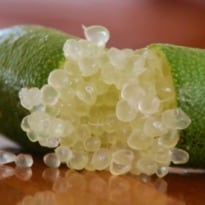The pulp from this distinctly ocker fruit explodes in the mouth and sets it apart from the rest of the fruits in the greengrocer
Slender, gnarly and filled with tiny, tangy jewels that burst in the mouth, finger limes are as intriguing as they are delicious.
Of all the flora inherited by Australia when Gondwana went to pieces, native limes are some of our most valuable plantings, in particular, the gherkin-like finger lime.
Known scientifically as citrus Australasica, this distinctly ocker fruit goes by a variety of species and street names, the most evocative of these monikers being "lime caviar". It's a fair descriptor: the way the fruit's pulp explodes in the mouth sets it right apart from the rest of the fruits in the greengrocer.
They've certainly made a splash in the restaurant world. "For me it's the perfect fruit," says Paul Wilson, culinary director at Bondi's Icebergs and long-time advocate for the distinctly Australian citrus.
"Mother Nature's done everything for you. When you taste the lime, it's got this lovely sweet and sour perfume, is very balanced and doesn't need much else. We use finger limes on oysters, but I also like using them on margaritas so you get that lovely waft of native lime with your first mouthful."
Believed to be up to 18 million years old, finger limes are endemic to the Queensland and New South Wales border area. The thorny, hardy plants grew abundantly in the Big Scrub, a vast subtropical rainforest on the northern New South Wales coast that, sadly, was cleared by settlers for agricultural use.
Fortunately, some plants survived the cull. In the case of long-time Lismore finger lime growers John and Robyn Musgrave, a wild-growing shrub on their property, once part of the Big Scrub, served as the "mother tree" for their orchard.
Most growers, however, established their plantings using commercially propagated trees and, by extension, owe a debt of gratitude to a Bangalow citrus nursery owner, Judy Viola.
"As far as I know, I was the first person to start propagating finger limes commercially," says Viola, a self-taught horticulturist who has worked with citrus plants since age 19 (her last birthday cake has 62 candles on it). Her relationship with finger limes began in 1989 when a couple approached her to propagate a plant that they'd found on their property.
"I'd never seen this sort of wood before and thought, good grief," she recalls of that first encounter.
Thankfully, Viola's four decades of citrus experience served her well and, to her delight, the 25 plants she budded all took. Since identifying this first cultivar (the species was called Alstonville, after the area the original plant was found), Viola has named close to a hundred different varieties.
While more Australians are becoming aware of the fruit's culinary value, the initial interest in finger limes was largely international. Intriguingly, at some time in the mid-60s (accounts on the actual date vary) finger lime seeds made their way from Sydney to California. Not only is "Australian finger lime" now part of the University of California's citrus variety collection, but a handful of American farmers are also growing the fruit commercially.
Back on Terra Australis, finger limes are planted from Mount Tamborine in Queensland to Pemberton in the west, making fresh limes available from January to June. While in-season fruit is always best in terms of quality and price ($50 per kilogram isn't an uncommon amount for export quality specimens), finger limes can be stored in the freezer for up to a year with only minimal loss of crunchiness. They're also incredibly versatile and work in any situation calling for regular lime - just keep them away from heat.
"Once you cook finger lime, it becomes like any other lime, really, and loses its delicate flavour and texture," says Wilson.
"It's something I believe is best used as a condiment or a garnish or in cold sauces."
Available from: specialist grocers including the Boatshed (Cottesloe, WA), the Vegetable Connection (Fitzroy, Vic), Waterside Fruit Connection (Pyrmont, NSW) and Thomas Dux (national).
Photo: A tangy margarita. Photograph: Hardie Grant
Frozen finger lime margarita
Preparation time: 5 minutes
Serves: four
120ml silver tequila
90ml fresh squeezed lime juice and finely grated zest (approx 2 limes)
30ml Cointreau
2 cups crushed ice
Agave syrup, to taste
1 finger lime, to garnish
Method
Combine the tequila, lime juice and zest, Cointreau and ice in a blender and puree until slushy.
Sweeten with agave and pour into chilled margarita glasses.
To garnish, cut the finger lime in half crossways and squeeze the flesh out on top of the margarita.
Photo: Finger limes are packed with caviar-type globes of citrus goodness that pop satisfyingly in your mouth. Photograph: Paul Carter/AAP Image





